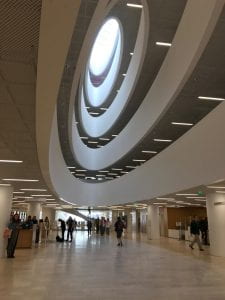Recently, I was given the opportunity to visit the University of Helsinki as part of the International Staff Exchange Week (ISEW).
This was part of the erasmus+ opportunity in which individuals from different areas of academia and academic support meet to share ideas and best practice. After encouragement from our Erasmus officers within the University, I applied to the staff exchange week in Helsinki. After putting in my application, I was quite surprised to have been offered a place as I am a newly qualified librarian working in my first post-degree role.
Getting to Helsinki
Travelling to Helsinki was quite an adventure, as this was my second flight ever and thus it was a little nerve wracking to travel alone. However, despite my nerves, it was very easy to travel through the airport and after several cups of tea in the airport, I was in Helsinki.
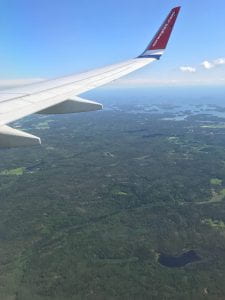
When I arrived, I had my first taste of the trains in Helsinki. They were fast and clean, quite a world from the rickety trains I was used to in the UK!
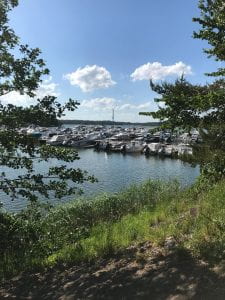
The first night, I went for a short walk to explore the Toloo area of Helsinki. I was struck by the greenery of the area, with ducks and wildlife not 10 minutes from the city centre.
Day one
As this was an international staff exchange week, there were a variety of staff who work in varying libraries and with different roles. From the moment I met all the other librarians, I felt welcomed. It is a fact that no matter where or who they are, librarians are always lovely and kind people, and this week was no exception. We had all travelled from across Europe and as far as Israel to participate in this week and we all became fast friends.
When the group had assembled, we all set off towards the University of Helsinki. After a quick tram ride, we were outside Kaiser Library.
This stunning building was constructed in 2011 as an amalgamation of several smaller research libraries. As such, it had a fantastically modern interior, and we were all keen to explore the library. After promises that we would be able to tour the library later, we all set off to the second floor classroom learn more about this institution.
As with many historical Universities in Europe, the University of Helsinki had a rich history with many changes over its time. Originally founded as an institution for boys by Queen Christina of Sweden in 1640, it has gone on to become the largest University in Finland. It currently is attended by 40,000 students. It is the largest multidisciplinary university in Finland, with a strong focus upon research, and is in the times higher education top 100 universities in the world.
After a lovely lunch, we all set off to the National Library. It felt like we had stepped back in time or into a fairy-tale, with large tones along the walls and carved wooden beams. This national library also had a rich and fascinating history, having previously been the national repository for Russian titles from 1820 to 1917. After a large fire destroyed much of their stock, they were sent a large number of titles from Russian academics to rebuild their collection. Now, the library serves as a legal deposit for all Finnish published books, which is the equivalent of the British library within the UK.
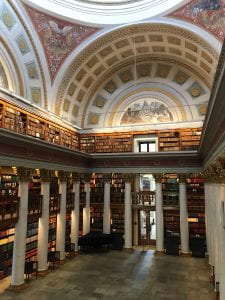
Unlike many national libraries, this institution had a number of open stacks to use and any citizen of Finland was able to use the material within the collection, however the national collection may not leave the building. With a special collection such as this, featuring the most comprehensive collections of Russian literature in the world, it is very impressive that the collection is so accessible.
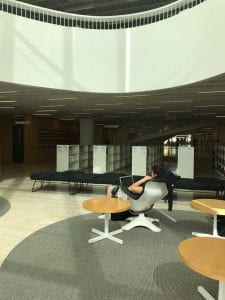
After leaving the National library, we returned to Kaiser House and began an official tour of their facilitators. This academic library was very different to the historical building we previously visited, however, it was still highly impressive.
With a variety of resources and study spaces, this library, as with all the other libraries we visited, was open to the public to use and no cards were required to access the building. This focus on openness was key within Helsinki, and it was reflected not only within the focus upon open access and open science, but also within the buildings themselves. Large open spaces, with bright white walls marked the Kaiser library as a truly open space to come and work. There was even a roof terrace looking out over the city rooftops for students to enjoy whilst they worked.
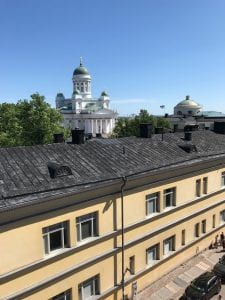
After an exciting day of visiting libraries, we all enjoyed large communal feast on the roof terrace of Tooloo towers. With platters of Reindeer pie, and a collection of sweet treats from around the world. As I set off to bed, it truly hit me that the sun did not set until 11pm, and when I finally left the terrace, everything was bathed in an orange glow, but it was still several hours before the city was truly dark.
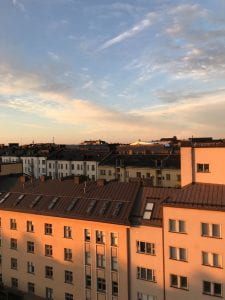
Day Two
On the second day, we all set off to the Terkko Health Hub, a specialised library for medical studies within the University of Helsinki. Modelled after the MIT library, the focus within this building was upon innovation, with many medical tech startups also calling this library their home.
In this library, a number of talks were held on the use of space within the library, including the implementation of a stage within the library for talks and performances, and the impact of 24 hour opening within a UK university. I also hosted a successful cognitive mapping activity inspired by the work of Andy Priestner. In this activity, I asked librarians to map out their library spaces over the course of 6 minutes, using a number of coloured pens brought all the way from Wilko in Lincoln. I was so pleased with the enthusiasm displayed by everyone, as all of the librarians were keen to show their maps and discuss how this representation displayed their perceptions of the library.
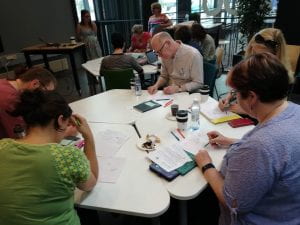
Once we had finished cognitive mapping, we all set off on a tour of the health hub. I particularly enjoyed luxuriating in the indoor hammock on the first floor, which was very comfortable.
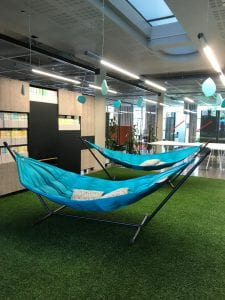
The entire building featured lovely pockets of plants, which was a feature I noticed in all of the Finnish libraries. These plants created a lovely contrast to the sleek modern facilities within the health hub and gave the building a homely feeling.
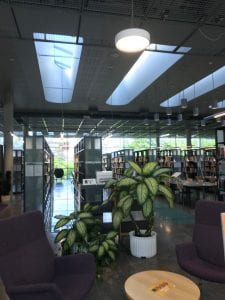
Next we ventured to the library, which I may hesitantly name, as one of my favourites of the trip (it is so hard to choose), the Oodi public library. This public library had been recently built and opened in 2018 on the eve of Finnish independence as a public space to be used by all. From afar, the ripple-like design of the building resembled a large boat or a modern statue. Inside, it was a marvel of design and a shining example of the beauty of public libraries.
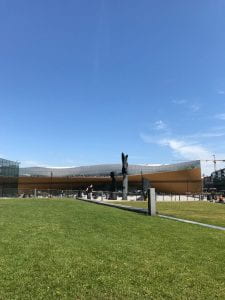
On the bottom floor were a number of different services, including a cafe, a cinema and several tables of fiction books to grab. The second floor contained a bustling collection of different work-spaces, including a large selection of sewing machines, 3-D printers, iPad’s and Virtual Reality machines. It truly felt like stepping into the future, as there were a wealth of resources freely accessible to all.
Whilst these maker spaces were a lovely example of how library space can be harnessed to serve the community, as a librarian, my heart truly belonged to the third floor, appropriately named ‘book heaven’.
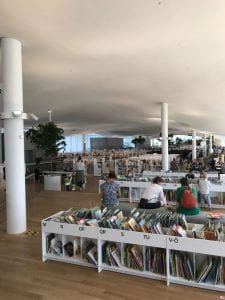
A floating ceiling with a collection of trees nestled between the bookshelf stacks; it was a truly magical place. There was a large children’s area with soft play features on one end of the library, and a large set of stairs with study spaces lining each side. The large windows made the space feel light and airy, and I wholeheartedly recommend anyone who ever finds themselves in Finland to visit this marvel of librarianship.
Day Three
On day three we enjoyed a number of presentations on open access and open data. We travelled to the University of Helsinki and visited the Kampula library to listen to a number of talks about Altmetrics and data-support. We learnt about the different techniques that librarians have used to engage with their students and faculty, in sharing their data and promoting their research. We also listened to a number of talks about information literacy and how this can be effectively promoted within the university. One very interesting point which I heard reiterated was the discussion of how academics typically prefer physical flyers for the promotion of library events. This countered my current understanding of the move towards digital and thus raised an interesting point which I would like to explore in the future.
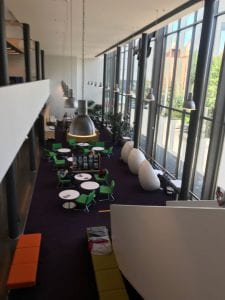
Following these talks, we enjoyed a tour Kumpula library. It was an incredibly technologically advanced library, with large touchscreens to view the space. All of the group rooms were climate controlled with booking information on a number of small screens on the outside of each group room. There was also a number of large screens displaying information about the number of people using the library and the free study spaces.
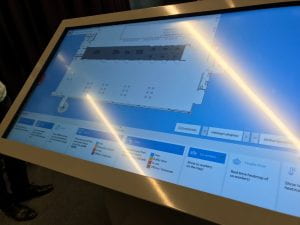
In the evening we visited the Sauna, which was a once in a lifetime experience which I absolutely adored. We sat in the sauna and jumped into the sea which was an incredible experience.
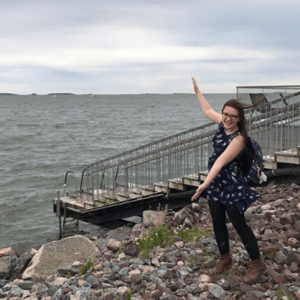
Day Four
On day four we visited the Viikki campus and carried out a competence mapping activity. This was a large green campus surrounded by fields, despite not being far from the busy city. It was an idyllic setting, and when we arrived, we carried out a competence mapping activity in which we mapped out the competencies required for a new person starting in your current role. It was a rewarding activity to see your own strengths and potential areas of improvement clearly.
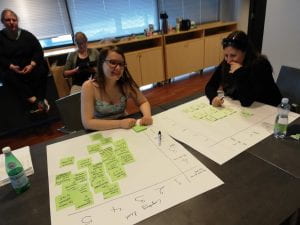
We also heard a talk about the charity work carried out by the library within the country of Eritrea. They had donated resources, as well as a fleet of computers to aid with the University within the region. Following this discussion we visited the two libraries within the campus. Unusually for a university, the building contained both an academic and public library with no barriers between the two. The public library was open with large spaces for children to use books and a large fiction collection.
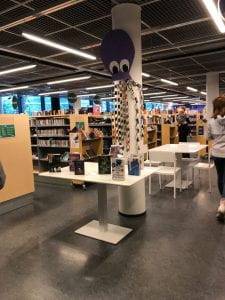
One of the most impressive features within both the academic and public library was the the multiple indoor gardens within the library. This space was accessible for people to sit and read, but also featured a number of tables to allow both the public and students to study within the idyllic space. This was a necessity within the cold Finnish winters, but as we had arrived during the summer months, fruit was growing from one of the orange trees within the garden. If there was one feature of all of the academic libraries which I could transport home from Helsinki, it would be these indoor gardens within the library.
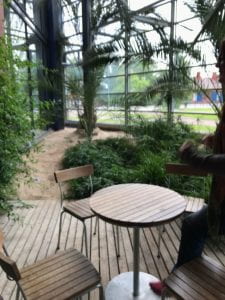
Day Five
For the final day, we left the University of Helsinki, and travelled slightly further out of the city to Aalto University, which featured the ‘The Harald Herlin Learning Centre’ library which was designed by the famous architect Alvar Aalto in 1970. It was truly a marvel of design and maintained the same furnishings as those designed at the time. Alvar Aalto had a very distinct modernist style which was visible throughout the library, and even the chairs and the staff room within the building featured interesting designs and appeared to all be pieces of art themselves.
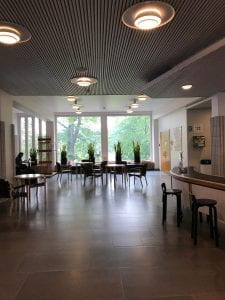
During the tour of the library, we discussed the advantages of having such an iconic space for students to use, as well as the difficulties in maintaining the libraries original design with the changing needs of students within the modern age. One manner in which the library had adjusted to fit within modern student requirements was turning what was previously a storage for the main collection into a collection of various study spaces. Despite the space limitations, they had created an open and interesting space which fit within the spirit of the building. This was done through the integration of interesting study spaces, such as hanging chairs and holes within the’wall to sit in, which gave the library interesting atmosphere in which to study.
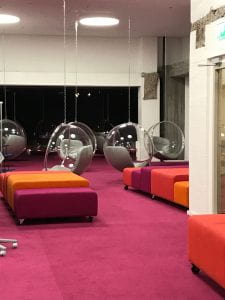
It was truly enjoyable to spend time within this library, and it gave me a great deal of inspiration for how a library can also be a piece of architectural history.
For the final library space, we returned to the University of Helsinki for the last time and visited the ‘Think Corner’. This area was reminiscent of the ‘learning hubs’ which can be found within a number of UK universities, such as ‘the Diamond’ at the University of Sheffield. Whilst a library space, there were no stacks and there was a greater focus upon study spaces which foster comfort and community. During the tour, the guide described it as a ‘living room for the university’ and this appeared fitting as the wooden interior gave the space an unexpected cosiness within the academic space.
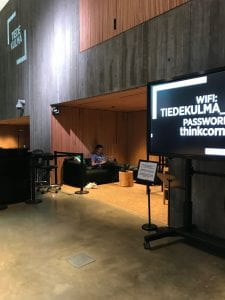
Featuring a large area on the ground floor for talks and presentations, the upstairs of the building was a hub of technology with VR equipment and group rooms. This floor also featured a large blackboard with advice on how best to use the space, with room for people to make suggestions on potential improvements within the ‘Think Corner’.
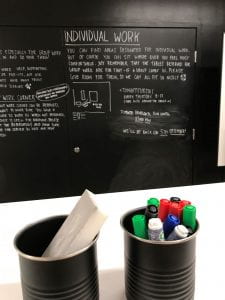
Summary
In summary, I would wholeheartedly recommend the Erasmus staff exchange week to anyone who works within the field of librarianship. It was rewarding and I returned to Lincoln bursting with ideas for the future and ways we can improve our service. This trip also allowed me to gain a greater appreciation for our own libraries, and how our focus upon customer service and user experience makes our service great.
In conclusion, I also would like to thank all of the staff at the University of Helsinki libraries and all of the fellow librarians, as they all made the trip so thoroughly enjoyable.
